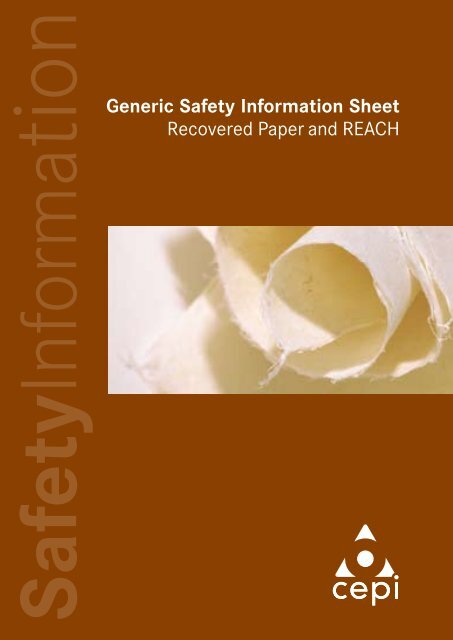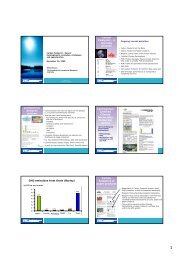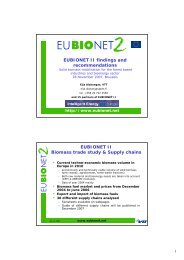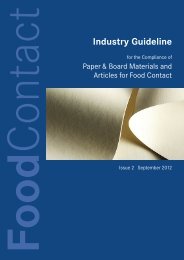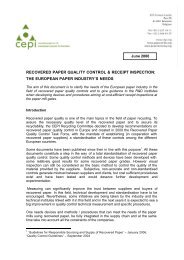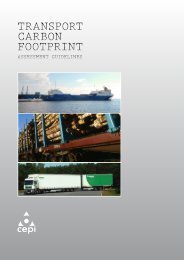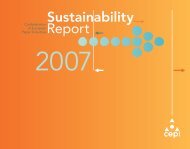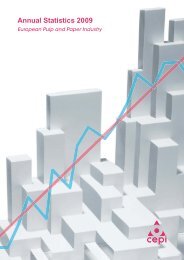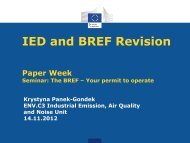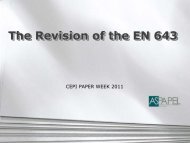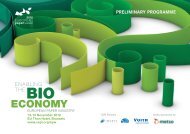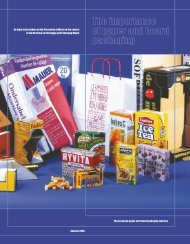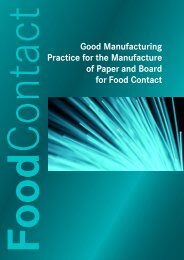Generic Safety Information Sheet Recovered Paper and REACH
Generic Safety Information Sheet Recovered Paper and REACH
Generic Safety Information Sheet Recovered Paper and REACH
- No tags were found...
You also want an ePaper? Increase the reach of your titles
YUMPU automatically turns print PDFs into web optimized ePapers that Google loves.
<strong>Safety</strong><strong>Information</strong><strong>Generic</strong> <strong>Safety</strong> <strong>Information</strong> <strong>Sheet</strong><strong>Recovered</strong> <strong>Paper</strong> <strong>and</strong> <strong>REACH</strong>
<strong>Generic</strong> <strong>Safety</strong> <strong>Information</strong> <strong>Sheet</strong><strong>Recovered</strong> <strong>Paper</strong> <strong>and</strong> <strong>REACH</strong>REC/040/09April 2009
Contents2 Background2 <strong>Paper</strong> Recycling3 Reach Regulation3 <strong>Recovered</strong> substances <strong>and</strong> <strong>REACH</strong>5 <strong>Safety</strong> information requirements5 <strong>Information</strong> possibilities under <strong>REACH</strong>6 <strong>Generic</strong> <strong>Safety</strong> <strong>Information</strong> on <strong>Recovered</strong> <strong>Paper</strong>6 Identification of the substance7 Hazards identification7 other information for enabling appropriate risk management measures8 validity8 disclaimer9 Annex9 decision tree for recovered paper1
Background<strong>Paper</strong> RecyclingOver 60 million tonnes of recovered paper was collected for recycling in Europe (EU27 + Norway <strong>and</strong>Switzerl<strong>and</strong>) in 2007. This corresponds to a 64,5% recycling rate for paper <strong>and</strong> board.The trend is growing: Since 1991 utilisation of recovered paper increased by 123% whereas Europeanpaper production increased at the same time by 56%. This trend is continuing <strong>and</strong> industry hasvoluntarily committed to increasing recycling (European Declaration on <strong>Paper</strong> Recycling).The paper recovery chain is one of various agents, starting with conversion of paper for end-users ofpaper products <strong>and</strong> ending in recycling into new paper. To facilitate precise discussions on the issuein the various steps of recovery, one has to distinguish between recovered paper <strong>and</strong> recycled paper:<strong>Recovered</strong> paper:used paper based articles, collected <strong>and</strong> where appropriate cleaned by dry sorting. No chemicalreaction, no new substances produced. A substance or, sometimes, a mixture in <strong>REACH</strong>.Recycled paper:an article, complying with <strong>REACH</strong> like virgin paper.For the purposes of this document, only the recovered paper is relevant. The terms are furtherexplained in the chart below.RecoveryConsumerClean <strong>and</strong> sort used paper to produceRAW MATERIAL for the paper industryRecyclingUse recovered paper to produceNEW RECYCLED PAPERTHE PAPER & BOARD RECYCLING CHAINCHART: Terms <strong>and</strong> definitions used in paper recycling.<strong>Paper</strong> recovery is a chain of agents that work together.2
<strong>REACH</strong> Regulation<strong>REACH</strong> is a European Community Regulation on chemicals <strong>and</strong> their safe use (EC 1907/2006).It deals with the Registration, Evaluation, Authorisation <strong>and</strong> Restriction of Chemical substances.The law entered into force on 1 June 2007.The aim of <strong>REACH</strong> is to improve the protection of human health <strong>and</strong> the environment through better<strong>and</strong> earlier identification of the intrinsic properties of chemical substances. The <strong>REACH</strong> Regulationgives greater responsibility to industry to manage the risks from chemicals <strong>and</strong> to provide safetyinformation on the substances.<strong>REACH</strong> provisions will be phased-in over 11 years. Companies can find explanations of <strong>REACH</strong> inthe guidance documents <strong>and</strong> can contact a number of helpdesks: CEPI has issued paper industryspecific guidance 1 which is periodically updated.Pursuant to Article 2(2) of <strong>REACH</strong>, waste materials, including those from recovery processes, arenot considered as substances, mixtures or articles. Therefore, for the purpose of <strong>REACH</strong>, recoveredsubstances (on their own, in mixtures or in articles) should only be understood as substances that,after having been part of waste materials, have ceased to be waste according to the criteria set bythe Waste Directive (2008/98/EC).Inversely, recovered paper can also be continued to be recycled as waste without falling under<strong>REACH</strong>. This may be needed in special cases where e.g. non-paper elements in certain recoveredpaper articles are too complex regarding the information requirements to comply with <strong>REACH</strong>, orwhen the collected paper has not been confirmed to comply with end-of-waste criteria.<strong>Recovered</strong> substances <strong>and</strong> <strong>REACH</strong>The Commission issued in October 2008 “Waste <strong>and</strong> <strong>Recovered</strong> Substances” (CA/24/2008 rev.2) 2which clarifies the general principles for waste <strong>and</strong> recovered substances for <strong>REACH</strong>, <strong>and</strong> givesuseful interpretation for the major recovered materials including paper. Firstly, the documentacknowledges the heterogeneous nature of recovered substances:“<strong>Recovered</strong> substances may contain impurities which may distinguish them from correspondingmaterials not deriving from recovery processes. This is in particular the case when recoveredmaterials contain unintended constituents which have no function for the recovered material <strong>and</strong> theonly reason for their presence in the recovered material is that they were part of the input waste forthe recovery process. The content <strong>and</strong> nature of such unintended constituents may vary significantlyfrom batch to batch (e.g. in time <strong>and</strong> location). Full knowledge of the exact composition in eachsuch case may require substantial analytical efforts. While such constituents may have originallybeen intentionally added as substances to form a mixture, their presence in the recovered materialmay be unintended (depending on whether these constituents have a specific function or not) <strong>and</strong>therefore, they can be considered as impurities, which do not require separate registration.”1 CEPI guidance document for implementing <strong>REACH</strong> in pulp <strong>and</strong> paper industry (ENV/079/08 )2 This document will later be adopted by European Chemicals Agency, ECHA, in the series of <strong>REACH</strong> implementation guidance documents.The Agency has the task of providing technical <strong>and</strong> scientific guidance <strong>and</strong> tools for the operation of the Regulation (EC) No 1907/2006(<strong>REACH</strong>) under its Article 77(2).3
Secondly, the document establishes that recovered paper, for the purposes of <strong>REACH</strong>, is asubstance (or in some cases a mixture of two or more substances, see below). <strong>Recovered</strong> papermainly consists of cellulose pulp. EINECS identifies cellulose pulp as follows:“The fibrous substances obtained from the treatment of lignocellulosic substances (wood orother agricultural fiber sources) with one or more aqueous solutions of pulping <strong>and</strong>/or bleachingchemicals. Composed of cellulose, hemi-cellulose, lignin, <strong>and</strong> other minor components. The relativeamounts of these components depend on the extent of the pulping <strong>and</strong> bleaching processes.”(EINECS number 265-995-8).Cellulose pulp is listed in Annex IV, <strong>and</strong> consequently, is exempted from registration, downstreamuser <strong>and</strong> evaluation obligations. <strong>Recovered</strong> paper may contain other constituents such as pigments,inks, glues, fillers, etc. Regarding the recovery <strong>and</strong> recycling process, constituents that haveno specific function in the material (cellulose pulp), can therefore be considered as impurities.<strong>Recovered</strong> paper consisting exclusively of cellulose pulp with impurities will therefore beexempt from registration, downstream user <strong>and</strong> evaluation obligations.In case a recovered paper grade has a non-celullose pulp element in excess of 20% w/w 3 , thiselement should be considered as an additional substance <strong>and</strong> the grade as a mixture of cellulosepulp <strong>and</strong> the substance concerned. This requires a characterisation of recovered paper for findingout what a typical constitution of recovered paper grades is; such characterisation was first done byCEPI in November 2008 <strong>and</strong> will be repeated periodically. No batch by batch testing is required 4 .Whereas cellulose pulp is exempted from the main requirements of <strong>REACH</strong> being listed in Annex IV,those other substances may be exempted either by being included in Annex IV or V of <strong>REACH</strong>, or byusing the exemption provided for in Article 2.7d of <strong>REACH</strong> Regulation. In any case, the substance hasto be identified <strong>and</strong>, in case of Article 2.7d, registered.Finally, the document gives guidance in establishing whether the substance is the same as the onethat was registered:“In assessing whether the recovered substance is the same as a substance that has already beenregistered or whether the substances are different, recovery installations need to apply the rules ofthe guidance on substance identification <strong>and</strong> the guidance on data sharing. In particular, it shouldbe noted that this is an assessment that recovery installations need to make themselves. There is noconfirmation given on “sameness” by the European Chemicals Agency.”However,“for substances with a well-defined composition (i.e. mono-constituent <strong>and</strong> multi-constituentssubstances) the sameness of the naming is in principle sufficient to be able to share data eventhough certain impurities might lead to a different classification/hazard profile. Only in cases3 The 20/80 rule is set in the Commission document as a rule of thumb: Those exceeding 20% of the weight should be considered anindividual substance instead. Also any substance that is intentionally added to the mixture should be considered the same way. The latter,however, is not done with recovered paper.4 In cases where such constituents are regularly close to this limit, it is recommended to take a safe approach <strong>and</strong> consider the constituentas a separate substance. Where constituents exceed 20% only in rare, individual batches which cannot be realistically expected under normalconditions, those constituents do not have to be considered as separate substances. It is also not necessary to examine each individual batchof waste material for the presence of such constituents.4
where all data is clearly not suitable for the other substance these substances can be regarded asdifferent (e.g. in case of very different physical properties which have essential impact on the hazardproperties, like water solubility).” 5It is also worth noting that the registration need not have been done by the same entity or within thesame supply chain as the recovery; it is sufficient that someone has registered the substance earlier 6 .<strong>Safety</strong> information requirementsArticle 2 (7)(d) provides that “the information required by Articles 31 or 32 relating to the substancethat has been registered in accordance with Title II is available to the establishment undertakingthe recovery”. How this information is obtained is not further specified in this provision. Suchinformation only needs to be available for substances. Impurities are part of substances <strong>and</strong> theinformation does not therefore have to be available for the impurity on its own.The Commission has invited the relevant industry associations, including CEPI, to produce aguidance document on writing <strong>Safety</strong> Data <strong>Sheet</strong>s (SDS) or, where SDS is not required, providingother information on the safe use of recovered materials. An ad-hoc group called the WasteRecovery Industry Chain (WRIC) drafted a document that was presented to the relevant Commissionservices on 26 March 2009. The Commission welcomed the results <strong>and</strong> the document will betransformed into an ECHA guidance document later in 2009.CEPI was taking part in the WRIC work; this information sheet is drafted according to the adoptedguidance <strong>and</strong> will be published as an annex to the guidance document (without the Background) assome other waste stream specific annexes such as the one on metal scrap.<strong>Information</strong>, requirements <strong>and</strong> possibilities under <strong>REACH</strong>Any actor in the supply chain shall comply with the duty to communicate information down <strong>and</strong> upthe supply chain as required in Articles 32 <strong>and</strong> 34, <strong>and</strong> keep the information available according toArticle 36 in the <strong>REACH</strong> regulation.CEPI has initially asked the European associations for inks <strong>and</strong> adhesives suppliers for theinformation relevant to the issuing of this <strong>Safety</strong> <strong>Information</strong> <strong>Sheet</strong>. However the spirit of the <strong>REACH</strong>regulation is that every actor has a responsibility to inform the supply chain when new, relevantelements are identified or about new knowledge; in communicating such information in the supplychain, CEPI should be informed too so as to enable updates to the <strong>Safety</strong> <strong>Information</strong> <strong>Sheet</strong>.In particular, these possibilities of accessing information will be used in monitoring the chemicalsafety of converted <strong>and</strong> printed products imported to EU.5 Guidance on registration, http://reach.jrc.it/docs/guidance_document/registration_en.htm, p.37.6 It is worth noting that this exemption does not require that the substance has been registered by an actor in the same supply chain.Therefore, it is sufficient that a registration was filed for the substance, either by a registrant in the same supply chain or by a registrant inanother supply chain. (European Commission CA/24/2008 rev.2)5
<strong>Generic</strong> <strong>Safety</strong> <strong>Information</strong> on <strong>Recovered</strong> <strong>Paper</strong> (04-2009)1. Identification of the substance (on its own or in a mixture)1.1 <strong>Recovered</strong> paper is used for manufacturing paper through a recycling process.1.2 Without prejudice to paragraph 1.3, recovered paper complying with EN 643 7 grades consistsof cellulose pulp with impurities 8 . Those impurities are not intentionally added for the recoveryprocess; the only reason for their presence in the recovered material is that they were part of theinput waste for the recovery process.1.3 The following EN 643 grades are considered to be a mixture of cellulose pulp <strong>and</strong> calciumcarbonate 9 with impurities: 2.08, 3.10 <strong>and</strong> 3.16(average share of CaCO 3in those grades is 29%, 30% <strong>and</strong> 33% respectively) 10 .1.4 General information:EC# 265-995-8CAS# 65996-61-4Substance Name Pulp, cellulose(DE: Pulp, Cellulose-; ES: pasta, celulosa; FR: pâte de cellulose)Molecular Formula Not applicableDescription:The fibrous substance obtained from the treatment of lignocellulosic substances (wood or otheragricultural fiber sources) with one or more aqueous solutions of pulping <strong>and</strong>/or bleaching chemicals.Composed of cellulose, hemi-cellulose, lignin, <strong>and</strong> other minor components. The relative amounts ofthese components depend on the extent of the pulping <strong>and</strong> bleaching processes.EC# 207-439-9CAS# 471-34-1Substance Name Calcium Carbonate(DE: Calciumcarbonat; ES: carbonato de calcio; FR: carbonate de calcium)Molecular Formula Ca CO 3Description:not available.1.5. Cellulose pulp <strong>and</strong> natural calcium carbonate are listed in Annex IV <strong>and</strong> V of the <strong>REACH</strong> regulation<strong>and</strong> thus exempted from registration.1.6. Precipitated calcium carbonate (PCC) is registered [registration number]7 European List of St<strong>and</strong>ard Grades of <strong>Recovered</strong> <strong>Paper</strong> <strong>and</strong> Board EN 643.8 “<strong>Recovered</strong> paper may contain other constituents such as pigments, inks, glues, fillers, etc. Regarding the recovery <strong>and</strong> recycling process,constituents that have no specific function in the material (cellulose pulp) can therefore be considered as impurities.” (European Commission,CA/24/2008 rev.2, 29 October 2008).9 An odourless, tasteless powder or crystal that occurs in nature as a common component in lithosphere. Precipitated calcium carbonate issimilar to natural calcium carbonate. In the paper industry both are used as a filler <strong>and</strong> coating pigment.10 Characterisation based on a CEPI study by PTS, Germany, in November 2008. Such characterisation will be updated periodically.6
2. Hazards identification2.1. <strong>Recovered</strong> paper does not meet the criteria for needing to produce a safety data sheet (SDS) asreferred to in Article 31.1 <strong>and</strong> 31.3 of <strong>REACH</strong> Regulation.2.2. The decision tree for assessing the need for a SDS is in the annex to this document.2.3. <strong>Recovered</strong> paper is not subject to:a) any authorisation under Title VII;b) any restriction imposed under Title VIII; orc) any specific conditions under section 3 of Annex XI to the <strong>REACH</strong> regulation;d) any requirement referred to in Article 31.1 nor is the threshold referred to in Article 31.3(b) 11exceeded.2.4. Collection of recovered paper <strong>and</strong> cleaning it by dry sorting are mechanical operations thatdo not cause chemical reactions; no new substances occur in nor are any substances added torecovered paper.3. Other information for enabling appropriate risk management measures3.1. <strong>Recovered</strong> paper classified as secondary material under the Waste Directive is to bereprocessed through material recycling into new articles (products <strong>and</strong> materials). It shall not beused for energy recovery or be disposed of.3.2. General <strong>and</strong> specific end-of-waste criteria, to be set under the Waste Directive, will includeminimum purity <strong>and</strong> management requirements.3.3. Prohibited sources of recovered paper listed in the Responsible Sourcing guidelines (CEPI 2007)<strong>and</strong> in Council of Europe Resolution AP (2002), Technical Annex 3:1. Contaminated waste paper <strong>and</strong> board from hospitals;2. <strong>Recovered</strong> paper <strong>and</strong> board which has been mixed with garbage <strong>and</strong> subsequently sorted out;3. Used stained sacks which have contained, for example, chemicals <strong>and</strong> foodstuffs;4. Covering materials, such as paper used for covering furniture during repair <strong>and</strong> painting work;5. Batches mainly consisting of carbonless copy paper;6. Waste paper from households containing used hygienic paper, such as used kitchen towels,h<strong>and</strong>kerchiefs <strong>and</strong> facial tissue;7. Old archives from libraries, offices, etc., if they contain PCBs.3.4. Transport, h<strong>and</strong>ling <strong>and</strong> storage: See Responsible Sourcing <strong>and</strong> Quality Management of<strong>Recovered</strong> <strong>Paper</strong> guidelines 12 for additional environmental <strong>and</strong> work safety considerations. As arespiratory protective measure in dusty areas one is recommended to wear a dust protection mask(filter P1).11 Substances referred to in Article 31.3(b) are also commonly known as “substances of very high concern” (SVHC) or “c<strong>and</strong>idate list”substances.12 www.cepi.org7
3.5. Any actor in the supply chain shall comply with the duty to communicate information down <strong>and</strong>up the supply chain as required in Articles 32 <strong>and</strong> 34, <strong>and</strong> keep the information available accordingto Article 36 in the <strong>REACH</strong> regulation.ValidityThis <strong>Information</strong> <strong>Sheet</strong> is valid was first issued 1 April 2009 <strong>and</strong> is valid in its updated version as of15 July until a new <strong>Information</strong> <strong>Sheet</strong> is issued (to be published at www.cepi.org) by 1 April 2011 atthe latest. <strong>REACH</strong> is applicable to recovered paper as of the date 13 the recovered paper ceases tobe waste.DisclaimerThe purpose of this document is to provide guidance to businesses dealing with recovered paper.Please note that this document contains the views of CEPI aisbl only <strong>and</strong> cannot be regarded as theofficial position of any individual company.CEPI does not accept any liability with regards to the information provided in this or any subsequentamendment of this document.13 A Commission decision on the waste / non-waste status of recovered paper is expected in late 2009 or early 2010.8
AnnexDecision tree for recovered paperwhether a <strong>Safety</strong> Data <strong>Sheet</strong> is required for recovered paper.YESIs the materialstill waste?NOAre the criteriaof Art 31 met?NOIs a SDSrequestedby a DU?YESYESNot the case withcurrent situationof recovered paperCreate a SDS(where relevantwith exposurescenarios)NOSDS not requiredLegend:SDS: <strong>Safety</strong> Data <strong>Sheet</strong>DU: Downstream UserArt 31: Article 31 of the <strong>REACH</strong> regulation9
This is a renewable, durable, re-usable <strong>and</strong> recyclable paper product - naturally supporting your ideas !10
April 2009REC/040/091st issue: 1 April 20091st update: 15 July 2009: added point 2.3 (d)CEPI aisblConfederation of European <strong>Paper</strong> Industries250 Avenue Louise, Box 80B-1050 BrusselsTel: +32 2 627 49 11 Fax: +32 2 646 81 37mail@cepi.orgwww.cepi.org www.paperonline.orgwww.paperrecovery.orgDesign by Ben Timmers (CEPI)


